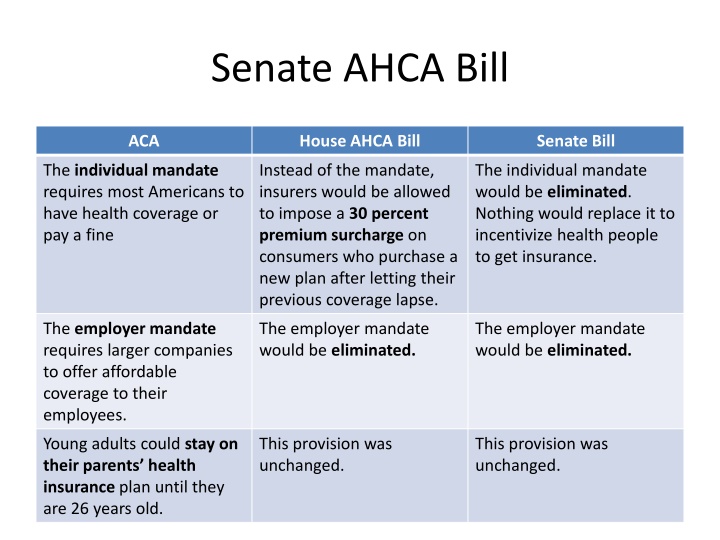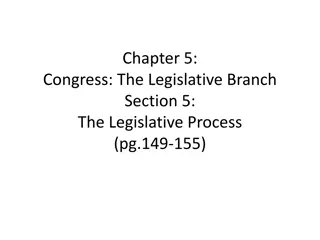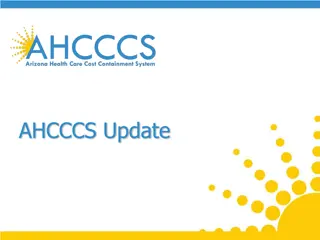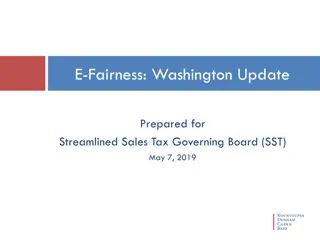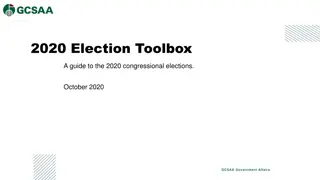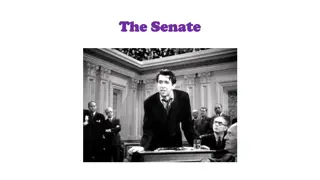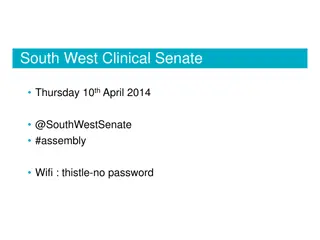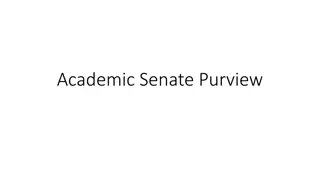Comparison of Healthcare Provisions in Senate and House AHCA Bills
The Senate AHCA bill proposes major changes to healthcare provisions compared to the current ACA, such as removing the individual mandate and employer mandate. Tax credits would be based primarily on age rather than income, and cost-sharing subsidies may end in 2020. Insurers could charge older customers more, and Medicaid funding would shift to per capita block grants, potentially leading to reduced federal funding. These changes could impact accessibility and affordability of healthcare for many Americans.
Download Presentation

Please find below an Image/Link to download the presentation.
The content on the website is provided AS IS for your information and personal use only. It may not be sold, licensed, or shared on other websites without obtaining consent from the author.If you encounter any issues during the download, it is possible that the publisher has removed the file from their server.
You are allowed to download the files provided on this website for personal or commercial use, subject to the condition that they are used lawfully. All files are the property of their respective owners.
The content on the website is provided AS IS for your information and personal use only. It may not be sold, licensed, or shared on other websites without obtaining consent from the author.
E N D
Presentation Transcript
Senate AHCA Bill ACA House AHCA Bill Senate Bill The individual mandate requires most Americans to have health coverage or pay a fine Instead of the mandate, insurers would be allowed to impose a 30 percent premium surcharge on consumers who purchase a new plan after letting their previous coverage lapse. The individual mandate would be eliminated. Nothing would replace it to incentivize health people to get insurance. The employer mandate requires larger companies to offer affordable coverage to their employees. The employer mandate would be eliminated. The employer mandate would be eliminated. Young adults could stay on their parents health insurance plan until they are 26 years old. This provision was unchanged. This provision was unchanged.
ACA House AHCA Bill Senate Bill ACA tax credits are primarily based on income, age and geography, which benefits lower-and moderate-income people buying coverage through ACA marketplaces. Tax credits would be based primarily on age. The amount would not increase when premiums increased, and people living in higher-cost areas would receive no additional money. Tax credits would be primarily based on age, income and geography. But they would be made to cover a skimpier plan, and people would need to be lower-income than under the ACA to receive them. Cost-sharing subsidies were provided to insurers to help some of their ACA customers cover deductibles and co- payments. These subsidies would end in 2020, although Trump could cut them off earlier. These subsidies would end in 2020, although Trump could cut them off earlier. Insurance companies are not allowed to increase someone s premiums or deny coverage based on preexisting conditions. States could allow insurers to increase someone s premiums based on their preexisting conditions if they had a break in coverage. States would have to set up some other program, such as a high risk pool to cover its sickest residents. Insurance companies are not allowed to increase someone s premiums or deny coverage based on preexisting conditions, though states may allow them to not cover costs associated with some conditions.
ACA House AHCA Bill Senate Bill Insurers can charge older customers up to three times as much as they charge younger customers. Insurers would be able to charge older customers up to five times as much as they charge younger customers. States could change this ration. Insurers can charge older customers up to five times as much as they charge younger customers. Individuals can contribute up to $3,400 and families up to $6,750 to pretax health saving accounts. Starting in 2018, individuals could contribute up to $6,550 and families could contribute up to $13,100 to pretax health savings accounts. People can contribute more to their health savings accounts than under ACA. No high-risk pools created. State would receive $130 billion over 10 years through a new Patient and State Stability Fund for high-risk pools and other programs to help sicker people. The stability fund would receive $112 billion over 10 years and would be aimed at reimbursing insurers who take big losses.
ACA House AHCA Bill Senate Bill Medicaid is an entitlement program with open-ended, matching federal funds for anyone who qualifies. Medicaid would be funded by giving states a per capital amount of block grant based on how much each state is spending, not adjusting for rising costs. Overall, this is expected to substantially decreased federal funding. Medicaid would be funded by giving states a per capita amount or block grant, beginning in 2021. the amount would grow more slowly than in the House bill, meaning bigger spending cuts overall. States can expand Medicaid to cover people making up to 138 percent of the poverty line, and the federal government would cover an outsize portion of their costs. States would not be able to expand Medicaid after this year. In states that do expand by the deadline, the federal government will pay a smaller portion of the cuss for people who sign up after 2019, making the expansion much more expensive for those states. For state that expand Medicaid, the federal government would pay a smaller portion of the cost starting in 2021.
ACA House ACHA Bill Senate Bill Insurers are required to cover certain categories of essential health benefits, such as hospital visits and mental-health care. States would be allowed to change what qualifies as an essential health benefit. States would be allowed to change what qualifies as an essential health benefit. Planned Parenthood is eligible for Medicaid reimbursements, but federal money cannot fund abortions. Planned Parenthood would face a one-year Medicaid funding freeze. Planned Parenthood would face a one-year Medicaid funding freeze. Caps on annual or lifetime coverage are banned for essential health benefits. The ban on caps itself is not changing, but because states could narrow what qualifies as an essential health benefit, more types of care could face caps. The ban on caps itself is not changing, but states could opt out of the ban.
